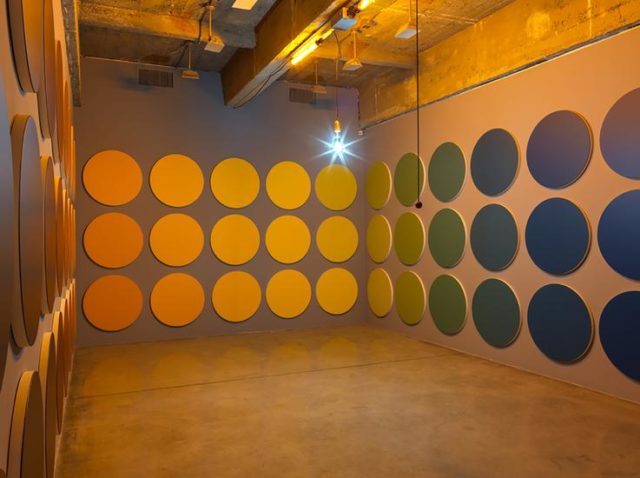
Olafur Eliasson
OLAFUR ELIASSON AT TANYA BONAKDAR
Closed April 22nd
Too late to see it now, but viewing Olafur Eliasson’s show at Tanya Bonakdar Gallery is like walking into a selfie chamber for tourists. This is particularly true for the room in which turning on a blue light under a yellow florescent transforms all the dots on a wall from grey to a veritable rainbow of colors. When I visited, the exhibition was packed with Asian tourists, all armed with cell phones.
That was the upstairs. Downstairs Eliasson affixed halved metal hoops to mirrors to create the illusion of full ellipses. The room was mostly empty—everyone knows what a mirror does, I guess. Lightbulbs, on the other hand, are different. They are mysterious!

Alice Neel at David Zwirner
ALICE NEEL AT DAVID ZWIRNER
Closed April 22nd
If there’s one takeaway from two rooms full of Alice Neel’s portraits, it’s the sheer magnitude of painterly virtuosity Neel brings to her subjects. Even in the earlier works showcased in the first half of the exhibition, which are more muted in palette and constrained in approach, Neel perfectly captures the personality of her sitters. (This show, curated by Hilton Als, assembles portraits of minorities who lived and worked in the neighborhoods she lived in.) Part of that has to do with her methods—she never posed her sitters so there’s an element of self-expression they are able to bring to the work. But another part of it may simply have to do with her personal temperament. It is well-known that Neel did not suffer fools easily—she may not have been able to paint a boring sitter if she tried.
Mostly, though, it’s her ability to render the most subtle gestures and body language that distinguishes Neel’s work from her contemporaries. The practiced upright posture of Armando Perez, for example, or the relaxed pose of her subject titled simply “The Arab“, seem to imbue the figures with such a distinct personality that the figures start to feel personable. In other words, they seem like actual people, which oddly, is a rare quality in contemporary portraiture.

Mecklenberg Autumn: Heat Lightening Eastward, 1983, Collage and oil on fiberboard.
ROMARE BEARDEN: BAYOU FEVER AND RELATED WORKS AT DC MOORE
Through April 29
There’s virtually nothing that can be written about Romare Bearden at DC Moore that the paintings don’t communicate better themselves. Sometimes the best art vibrates in a way words won’t ever emulate.
So, if you take nothing else home from this post, know that the one show in Chelsea to see before it closes this week is Romare Bearden at DC Moore. The exhibition includes a large number of water colors as well as a series of 21 collages made for the 1979 ballet, “Bayou Fever”. Set in Bayou’s Edge, Louisiana, the ballet and inspired watercolors tackle themes of the deep south, church and African American traditions. Brave, lush reds and oranges dominate the most powerful watercolor landscapes as if set on fire. In other watercolors and collages depicting groups of African Americans or lone figures in landscapes, a palette of greens and blues seem to glow in the twilight air. All of the work feels alive—even when depicting extreme poverty.
Plenty of references to African traditions and textiles contribute to that feeling, though strangely enough, there were also a bunch that reminded me of South Park animations. Those were the ones with chunky cut out figures and blocky architecture designed to work through gesture and feeling rather than an exact rendering. Nothing ever read as sloppy, though. In fact, the work was so moving, that eventually I had to leave the space, exhausted by the artist’s seemingly limitless creative ability. Not a bad way to end a day in Chelsea.


Comments on this entry are closed.